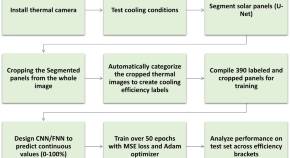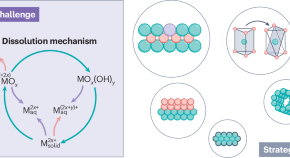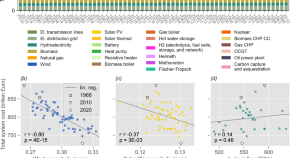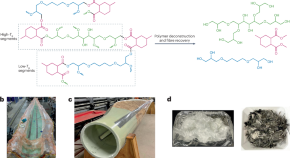Towards Sustainable Energy: A Systematic Review of Renewable Energy Sources, Technologies, and Public Opinions
Ieee account.
- Change Username/Password
- Update Address

Purchase Details
- Payment Options
- Order History
- View Purchased Documents
Profile Information
- Communications Preferences
- Profession and Education
- Technical Interests
- US & Canada: +1 800 678 4333
- Worldwide: +1 732 981 0060
- Contact & Support
- About IEEE Xplore
- Accessibility
- Terms of Use
- Nondiscrimination Policy
- Privacy & Opting Out of Cookies
A not-for-profit organization, IEEE is the world's largest technical professional organization dedicated to advancing technology for the benefit of humanity. © Copyright 2024 IEEE - All rights reserved. Use of this web site signifies your agreement to the terms and conditions.
Thank you for visiting nature.com. You are using a browser version with limited support for CSS. To obtain the best experience, we recommend you use a more up to date browser (or turn off compatibility mode in Internet Explorer). In the meantime, to ensure continued support, we are displaying the site without styles and JavaScript.
- View all journals
Renewable energy articles from across Nature Portfolio
Renewable energy is energy that comes from sources that are readily replenishable on short-timescales. Examples of these are solar radiation, wind, and biomass.
Related Subjects
- Geothermal energy
- Hydroelectricity
- Hydrogen energy
- Solar energy
- Wind energy
Latest Research and Reviews
Steering perovskite precursor solutions for multijunction photovoltaics.
- Shuaifeng Hu
- Henry J. Snaith

Deep regression analysis for enhanced thermal control in photovoltaic energy systems
- Wael M. Elmessery
- Abadeer Habib
- Abdallah E. Elwakeel

Modelling the transformation of energy-intensive industries based on site-specific investment decisions
- Marius Neuwirth
- Tobias Fleiter
- René Hofmann

Earth-abundant electrocatalysts for acidic oxygen evolution
Proton-exchange membrane water electrolysers often rely on scarce iridium or ruthenium catalysts at the anode, as many low-cost, earth-abundant catalysts cannot withstand the harsh operational conditions. This Review discusses the state of the art in earth-abundant water oxidation catalysts and examines their degradation mechanisms at multiple levels.
- Rendian Wan
- Tenghui Yuan

Six years of high-resolution monitoring data of 40 borehole heat exchangers
- Phillip Stoffel
- Norbert Klitzsch


Designing a sector-coupled European energy system robust to 60 years of historical weather data
Highly renewable energy systems, built on wind, solar PV, and sectoral integration, can handle year-to-year weather variability while ensuring resource adequacy and CO 2 neutrality, at 10% higher cost than systems designed for average weather patterns.
- Ebbe Kyhl Gøtske
- Gorm Bruun Andresen
- Marta Victoria
News and Comment

Geothermal power is vying to be a major player in the world’s clean-energy future
With technical advances and enthusiasm from policymakers, advocates say the time for next-generation geothermal has come.
- Davide Castelvecchi

How I’m turning seaweed into biofuel for cars on Barbados
Mechanical engineer Legena Henry converts sargassum and rum-distillery waste water to produce sustainable natural gas for vehicles.
- Kendall Powell

A wind of change in sustainability
Fibre-reinforced epoxy-amine resins are common materials for wind turbine blades, yet they are challenging to recycle. Now, researchers formulate an alternative resin using biomass-derived polyester with easier-to-break covalent linkages, demonstrating the industrial manufacturability and recyclability of the resin with a nine-metre blade prototype.
- Xing-Yuan Miao

Producing methane through organocatalysis
Electrochemical reduction of carbon dioxide to fuels and chemicals is usually mediated by metal-based catalysts. Now, a carbon electrode modified with an organic molecular catalyst demonstrates promising activity and selectivity for carbon dioxide electroreduction to methane via an unusual pathway.

Raising the bar for breakdown
Perovskite solar cells can be damaged when partially shaded, owing to currents flowing in reverse. Two research groups have now increased the breakdown voltage of the perovskite devices (the tolerance against this reverse bias degradation), one by using multilayer charge-selective contact stacks on the cathode side, and the other by using relatively thick, dense electrodes on the anode side.
- Erkan Aydin
Using the moisture in our midst
Sorbent materials that capture and release water molecules are key to technologies that turn the Earth’s ambient moisture into drinkable water and energy.
Quick links
- Explore articles by subject
- Guide to authors
- Editorial policies

IMAGES
COMMENTS
Sep 1, 2022 · Renewable energy (RE) is the key element of sustainable, environmentally friendly, and cost-effective electricity generation. An official report by International Energy Agency (IEA) states that the demand on fossil fuel usage to generate electricity has started to decrease since year 2019, along with the rise of RE usage to supply global energy demands.
May 23, 2019 · The use of renewable energy resources, such as solar, wind, and biomass will not diminish their availability. Sunlight being a constant source of energy is used to meet the ever-increasing energy need. This review discusses the world's energy needs, renewable energy technologies for domestic use, and highlights public opinions on renewable energy. A systematic review of the literature was ...
Apr 4, 2016 · Notwithstanding, renewable energy sources are the most outstanding alternative and the only solution to the growing challenges (Tiwari & Mishra, Citation 2011). In 2012, renewable energy sources supplied 22% of the total world energy generation (U.S. Energy Information Administration, Citation 2012) which was not possible a decade ago.
Aug 1, 2015 · This paper briefly presents the importance of renewable sources of energy owing to the backdrop of fossil fuel dilemma. Major emphasis is placed on the use of alternative energy technologies.
Nov 1, 2023 · Variable renewable energy (VREs) is a term that describes a type of renewable energy, such as solar and wind and their highly intermittent nature when compared to other RERs [116, 127]. Eenergy storage systems ESSs have been largely recognized as the ultimate solution to smoothing out the RERs power generation scheme.
Sep 1, 2022 · The energy resources have been split into three categories: fossil fuels, renewable resources and nuclear resources. Renewable energy sources are those resources which can be used to produce energy again and again, e.g. solar energy, wind energy, biomass energy, geothermal energy, etc. and are also often called alternative sources of energy.
Apr 24, 2022 · Then, several renewable energy sources, including wind, solar, hydro, and biomass, along with the worldwide energy capacity of each energy source are given with suitable examples and statistics.
May 23, 2019 · This paper aims to assess the situation of the energy system throughout the European Union member states (EU28), with a focus set on renewable energy and energy efficiency programs.
The use of renewable energy resources, such as solar, wind, and biomass will not diminish their availability. Sunlight being a constant source of energy is used to meet the ever-increasing energy need. This review discusses the world's energy needs, renewable energy technologies for domestic use, and highlights public opinions on renewable energy. A systematic review of the literature was ...
6 days ago · Highly renewable energy systems, built on wind, solar PV, and sectoral integration, ... Research Open Access 16 Dec 2024 Nature Communications. Volume: 15, P: 10680.